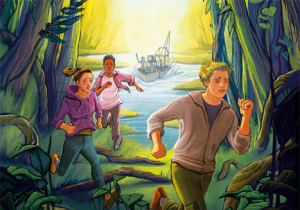
Borneo tribespeople primary resource
Learn all about the Iban people of Borneo and their traditional way of life
This primary resource introduces children to the Iban people of Borneo and their traditional way of life. What do the boys and girls of the Iban tribe eat for dinner? How do their chores compare with children from the UK? Do all the Iban children go to school?
Pupils will learn about a different type of culture, settlement and land use from what they are used to, in our National Geographic Kids’ Geography primary resource sheet.
The teaching resource can be used in study group tasks for comparing settlement and economic activity in Borneo with their own hometowns. It can be used as a printed handout for each pupil to review and annotate, or for display on the interactive whiteboard to share the information and photographs for class discussion.
Activity: Ask children to find Borneo on a world map. Do they know anything about the island? Pupils could imagine they are children of the Iban tribe, and using the comparison chart in the bottom right-hand corner of the resource sheet, they could write a piece of creative writing about life in the tribe. Alternatively, they could extend the chart with some of their own comparisons based on independent research.
N.B. The following information for mapping the resource documents to the school curriculum is specifically tailored to the English National Curriculum and Scottish Curriculum for Excellence. We are currently working to bring specifically tailored curriculum resource links for our other territories; including South Africa, Australia and New Zealand. If you have any queries about our upcoming curriculum resource links, please email: schools@ngkids.co.uk
This Geography primary resource assists with teaching the following Geography objectives from the National Curriculum:
- Pupils should extend their knowledge and understanding beyond the local area to include the United Kingdom and Europe, North and South America. This will include the location and characteristics of a range of the world’s most significant human and physical features.
National Curriculum Key Stage 1 Geography objective:
- Pupils should be taught to: use basic geographical vocabulary to refer to: key human features, including: city, town, village, factory, farm, house, office, port, harbour and shop
National Curriculum Key Stage 2 Geography objective:
- Pupils should be taught to: describe and understand key aspects of: human geography, including: types of settlement and land use, economic activity including trade links, and the distribution of natural resources including energy, food, minerals and water
This Geography primary resource assists with teaching the following Social Studies Second level objective from the Scottish Curriculum for Excellence:
- I can consider the advantages and disadvantages of a proposed land use development and discuss the impact this may have on the community.
Scottish Curriculum for Excellence Third level Social Studies objective:
- By comparing settlement and economic activity in two contrasting landscapes, I can reach conclusions about how landscapes influence human activity. I can explain my findings clearly to others.
- I can use a range of maps and geographical information systems to gather, interpret and present conclusions and can locate a range of features within Scotland, UK, Europe and the wider world.
- I can investigate the climate, physical features and living things of a natural environment different from my own and explain their interrelationship.
- I can identify the possible consequences of an environmental issue and make informed suggestions about ways to manage the impact.
Scottish Curriculum for Excellence Fourth level Social Studies objective:
- I can develop my understanding of the interaction between humans and the environment by describing and assessing the impact of human activity on an area.
Download primary resource
More Like

The Travelling Bookshop: Mim and the Anxious Artist

Cloudburst!

Facts about Mars









LEAVE A COMMENT
THANK YOU
Your comment will be checked and approved shortly.
WELL DONE,
YOUR COMMENT
HAS BEEN ADDED!
COMMENTS
CUSTOMIZE YOUR AVATAR